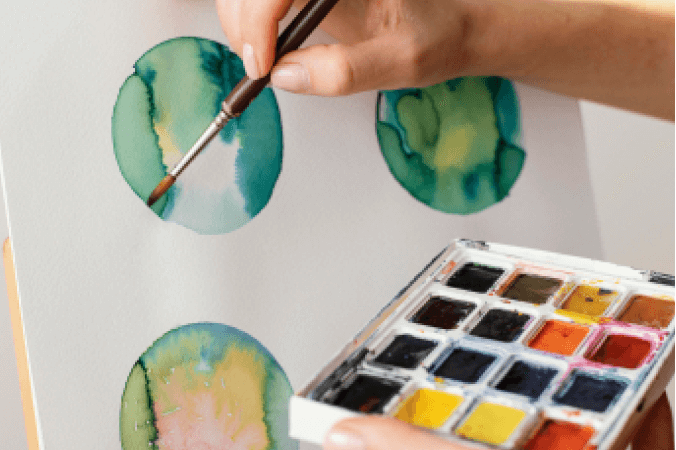JEREMY:
Hello, Helen. Sorry I’m late.
HELEN:
Hi, Jeremy, no problem. Well we’d better work out where we are on our project, I suppose.
JEREMY:
Yeah. I’ve looked at the drawings you’ve done for my story, ‘The Forest’, and I think they’re brilliant – they really create the atmosphere I had in mind when I was writing it.
HELEN:
I’m glad you like them.
JEREMY:
There are just a few suggestions I’d like to make.
JEREMY:
Now, I’m not sure about the drawing of the cave – it’s got trees all around it, which is great, but the drawing’s a bit too static, isn’t it? I think it needs some action.
HELEN:
Yes, there’s nothing happening. Perhaps I should add the boy – Malcolm, isn’t it? He would be walking up to it.
JEREMY:
Yes, let’s have Malcolm in the drawing. And what about putting in a tiger – the one that he makes friends with a bit later? Maybe it could be sitting under a tree washing itself.
HELEN:
And the tiger stops in the middle of what it’s doing when it sees Malcolm walking past.
JEREMY:
That’s a good idea.
HELEN:
OK, I’ll have a go at that.
JEREMY:
Then there’s the drawing of the crowd of men and women dancing. They’re just outside the forest, and there’s a lot going on.
HELEN:
That’s right, you wanted them to be watching a carnival procession, but I thought it would be too crowded. Do you think it works like this?
JEREMY:
Yes, I like what you’ve done. The only thing is, could you add Malcolm to it, without changing what’s already there.
HELEN:
What about having him sitting on the tree trunk on the right of the picture?
JEREMY:
Yes, that would be fine.
HELEN:
And do you want him watching the other people?
JEREMY:
No, he’s been left out of all the fun, so I’d like him to be crying – that’ll contrast nicely with the next picture, where he’s laughing at the clowns in the carnival.
HELEN:
Right, I’ll do that.
JEREMY:
And then the drawing of the people ice skating in the forest.
HELEN:
I wasn’t too happy with that one. Because they’re supposed to be skating on grass aren’t they?
JEREMY:
That’s right, and it’s frozen over. At the moment it doesn’t look quite right.
HELEN:
Mm, I see what you mean. I’ll have another go at that.
JEREMY:
And I like the wool hats they’re wearing. Maybe you could give each of them a scarf as well.
HELEN:
Yeah, that’s easy enough. They can be streaming out behind the people to suggest they’re skating really fast.
JEREMY:
Mm, great. Well that’s all on the drawings.
HELEN:
Right. So you’ve finished writing your story and I just need to finish illustrating it, and my story and your drawings are done.
HELEN:
So the next thing is to decide what exactly we need to write about in the report that goes with the stories, and how we’re going to divide the work.
HELEN:
What do you think about including a section on how we planned the project as a whole, Jeremy? That’s probably quite important.
JEREMY:
Yeah. Well, you’ve had most of the good ideas so far. How do you feel about drafting something, then we can go through it together and discuss it?
HELEN:
OK, that seems reasonable. And I could include something on how we came up with the ideas for our two stories, couldn’t I?
JEREMY:
Well, I’ve started writing something about that, so why don’t you do the same and we can include the two things.
HELEN:
Right. So what about our interpretation of the stories? Do we need to write about what we think they show, like the value of helping other people, all that sort of thing?
JEREMY:
That’s going to come up later isn’t it? I think everyone in the class is going to read each other’s stories and come up with their own interpretations which we’re going to discuss.
HELEN:
Oh, I missed that. So it isn’t going to be part of the report at all?
JEREMY:
No. But we need to write about the illustrations, because they’re an essential element of children’s experience of reading the stories. It’s probably easiest for you to write that section, as you know more about drawing than I do.
HELEN:
Maybe, but I find it quite hard to write about. I’d be happier if you did it.
JEREMY:
OK. So when do you think …
 Đáp án mình cần điền là một danh từ (một cái gì đó bị bao quanh bởi cây)
Đáp án mình cần điền là một danh từ (một cái gì đó bị bao quanh bởi cây)  Đầu tiên, Jeremy nhắc đến một cái hang, ''Now, I'm not sure about the drawing of the cave - it's got trees all around it''
Đầu tiên, Jeremy nhắc đến một cái hang, ''Now, I'm not sure about the drawing of the cave - it's got trees all around it'' 


